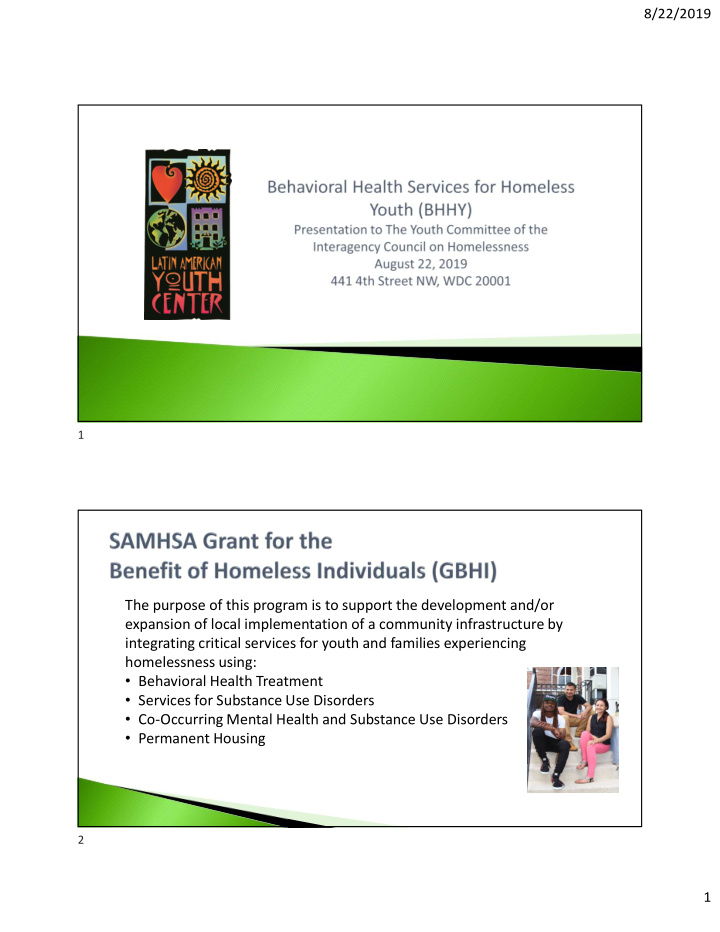



8/22/2019 1 The purpose of this program is to support the development and/or expansion of local implementation of a community infrastructure by integrating critical services for youth and families experiencing homelessness using: • Behavioral Health Treatment • Services for Substance Use Disorders • Co-Occurring Mental Health and Substance Use Disorders • Permanent Housing 2 1
8/22/2019 Five Year Grant Period: November 30, 2018 to November 29, 2023 Target Population: Youth ages 17-24 who are experiencing homelessness and living with substance use, mental health, or co-occurring disorders Target Number Served: 40 youth per year for total of 200 youth over 5 year period Length of Treatment: Six months 3 Elizabeth Mohler, Project Director and Clinical Supervisor Tyvon Hewitt, Outreach Worker/Case Manager Dora Guevara, Substance Use Disorders Treatment Counselor Charley Goldman, Mental Health Treatment Counselor Monica Morales, Program Coordinator 4 2
8/22/2019 Short-term Outcomes: Learn about substances/impact on health Improve problem solving/coping skills Improve communication skills Learn to identify triggers Learn to regulate emotions Better equipped to handle crisis situations Learn life skills Learn about available community resources 5 Intermediary Outcomes : Decreases or abstains from substance use Emotional status improves Behavior improves Improves the ability to build and sustain healthy relationships Symptoms subside Utilizes community resources 6 3
8/22/2019 Long-term Outcomes : Maintains a sustained decrease or abstinence from substance Improves overall functioning 7 Measurable Objectives: Youth will maintain a 65% attendance rate for individual counseling sessions Parent/caring adult will maintain a 65% attendance rate for appropriate counseling sessions 50% of youth will successfully complete the program by meeting their treatment goals 60% of youth will maintain functioning at six-month follow-up 50% of youth receiving SUD treatment will maintain abstinence or reduction from substance use at six-month follow-up 8 4
8/22/2019 Evidence Based Practices (EBPs): Motivational Interviewing, Trauma Focused – Cognitive Behavioral Therapy, Adolescent Community Reinforcement Approach Case Management: linkage to community resources, psycho-education, advocacy Life-Skills Groups: money management, time management, communication and healthy relationships Referrals to drug testing for youth 9 Number of clients served: 17 Age range 18-24 53% black 35% white 12% multiracial 58% identified as male 34% identified as female 8 % identified as gender non-binary 10 5
8/22/2019 Housing Status: 35% living in a shelter 35% couch surfing with family or friends 18% living in a housing program 12% living on the street or without consistent shelter Substances Used: 76% use cannabis 65% use alcohol 12% use other substances (including opiates and hallucinogens) 11 Primary tool to assess indicators of abstinence from substance use, housing status, employment status, criminal justice system involvement, access to services, retention in services, and social connectedness Administered by counselor Entered into SPARS database Three periods of data collection: baseline, 6 month, and discharge 12 6
8/22/2019 Supplementary Performance Measures Enrollment, demographics, and discharge data Counseling and case management attendance, parent engagement, referrals, modalities used Collected in ETO by all staff as applicable as youth enroll into the program and receive services 13 Evaluation team and program staff review data for completeness and accuracy on a quarterly basis and allow time for correction (SPARS and ETO data) In cases where the participant drops out of the program or is unavailable for a final session, counselor will attempt the contact the client for GPRA 14 7
8/22/2019 One-on-one program staff interviews 6 months after implementation Steering Committee focus group every 12 months 15 Evaluation Question Data Collection Instrument Data Analysis How did dosage, modality, or staff member affect the Mental Health attendance and Descriptive statistics and achieved outcomes? case notes and GPRA regression analysis How did the achieved outcomes differ across client GPRA Descriptive statistics and or caregiver individual factors? regression analysis How sustainable were the results over time? GPRA Descriptive statistics and regression analysis 16 8
8/22/2019 Evaluation Question Data Collection Instrument Data Analysis To what extent has the program met its goals and One-on-one program staff interviews Coding and thematic analysis objectives? Have any modifications been made to the program? Were there any barriers to program implementation? Steering Committee focus group Coding and thematic analysis What efforts were made to overcome barriers? How different was the program implemented from the original plan? What adjustments were made to the original plan? What were the reasons for the changes? 17 Yearly report to SAMHSA will include results of quantitative and qualitative analyses Six-month qualitative report from one-on-one interviews Bi-annual meetings to discuss to discuss performance measures, meetings will discuss findings from most recent annual assessment if applicable during time of year Discuss successes and barriers Opportunity for course correction and program modification 18 9
8/22/2019 Questions? For more information about BHHY or to make a referral contact bhreferrals@layc-dc.org 19 10
Recommend
More recommend